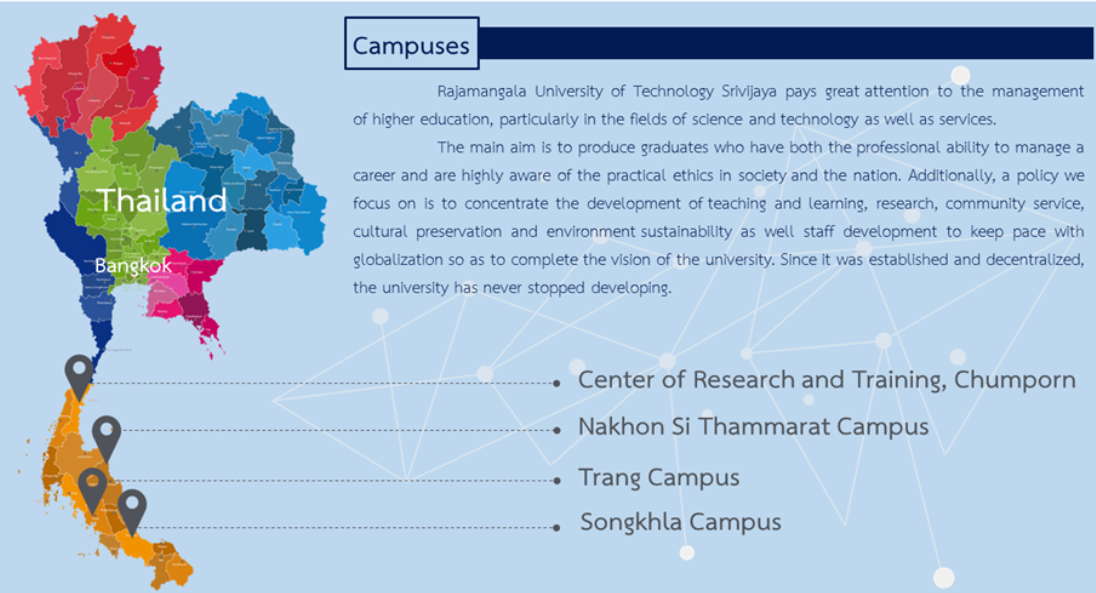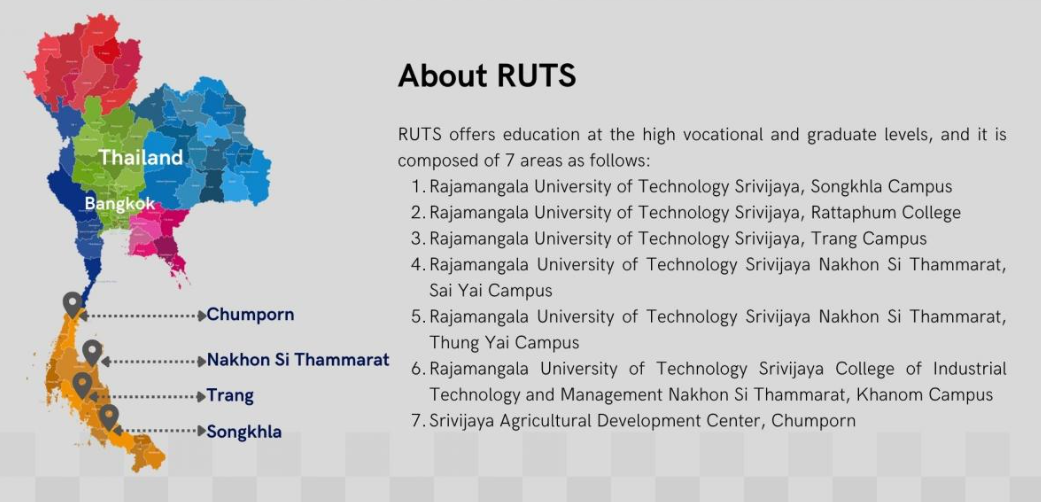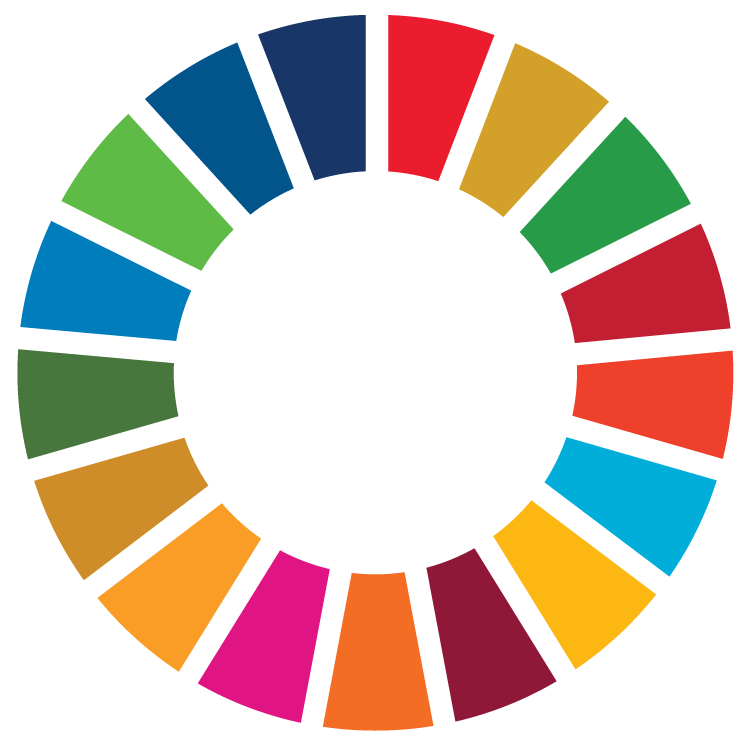Reporters:
Assoc. Prof. Dr. Chatree Homkhiew
Assist. Prof. Dr. Thanwit Naemsai
Assist. Prof. Dr. Thanakorn Damsud
Assist. Prof. Dr. Kosin Teeparuksapun
Evidence Date: Jan-December 2024
Details:
Rajamangala University of Technology Srivijaya (RUTS) located in southern Thailand. It is a prominent institution within the Rajamangala University of Technology (RMUT) consortium. RUTS prioritizes the efficient management of higher education, particularly in the fields of science, technology, and services. The principal objectives are to develop graduates who have the necessary professional skills for successful professions and a deep understanding of their ethical duties in society and the nation. Moreover, RUTS has instituted policies that emphasize the enhancement of research, pedagogy, community engagement, cultural conservation, environmental sustainability, and the continuous professional development of its personnel to ensure conformity with the exigencies of a globalized society and the achievement of the university’s aspirational objectives.
As shown in Figure 1, RUTS provides education at the advanced vocational and graduate levels. The institution is divided into four sites across the country. In addition to this, it offers education at the graduate and high vocational levels, offering instruction in seven different subject areas (Figure 2).

Figure 1. RUTS campus

Figure 2. Area of high vocational and graduated levels education of RUTS
Rajamangala University of Technology Srivijaya (RUTS) features a comprehensive academic framework, consisting of 12 faculties and 2 colleges. The faculties and colleges constitute the fundamental units of the institution, each focusing on specific academic disciplines and fields of study. The total number of employees of RUTS is 1405.
Related Indicator: Indicator 9.4.2.4 Quantity of academic personnel
A committed team of 748 academic staff, essential to the university’s educational framework, bolsters RUTS. These educators and professionals significantly contribute by offering guidance, education, and expertise to students across diverse disciplines.
Related Indicator: Indicator 9.4.2.1 Count of academic personnel by discipline: STEM
The academic staff distribution in STEM fields (science, technology, engineering, and mathematics) comprises 492 dedicated members. These individuals contribute a varied array of skills and knowledge, bolstering the university’s objective to promote teaching and research in essential fields such as science, technology, engineering, and mathematics. Their contributions are vital in fostering innovation, driving academic excellence, and equipping students with the skills needed to succeed in these rapidly evolving fields.
Related Indicator: Indicator 9.4.2.2 Count of academic personnel by discipline: Medicine
The allocation of academic personnel in the medical discipline comprises 38 committed professionals. These specialists are crucial in influencing the teaching and research landscape of the university’s medical programs. They offer specialized expertise, clinical experience, and mentorship to students, facilitating the preparation of the forthcoming generation of healthcare professionals. Their contributions are essential in advancing medical education, research, and the overall quality of healthcare training at the institution.
Related Indicator: Indicator 9.4.2.3 Number of academic staff by subject area: Arts and humanities/Social sciences.
The distribution of academic personnel in the fields of arts and humanities, encompassing social sciences, consists of 218 dedicated specialists. These educators and scholars provide substantial expertise and proficiency to respective disciplines, markedly improving critical thinking, creativity, and understanding of human society and culture. They contribute to various academic disciplines, including literature, history, philosophy, sociology, and psychology, through their instruction, research, and mentorship. Their efforts cultivate comprehensive graduates equipped with analytical abilities, cultural awareness, and the capability to address complex societal issues. Table 1 delineates the number of RUTS academic personnel categorized by faculties and colleges.
Table 1. Number of RUTS academic staff by faculties/colleges.
|
Faculty & College |
STEM |
Medicine |
Art & Humanities/Social Science |
|---|---|---|---|
|
Faculty of Science and Fisheries Technology |
55 |
– |
– |
|
Faculty of Engineering and Technology |
26 |
– |
– |
|
College of Hospitality of Tourism |
– |
– |
29 |
|
Faculty of Agriculture |
38 |
– |
– |
|
Faculty of Agro-industry |
13 |
– |
– |
|
Faculty of Veterinary Medicine |
– |
38 |
– |
|
Faculty of Science and Technology |
64 |
21 | |
|
Faculty of Management Technology |
13 |
40 | |
|
College of Industrial Technology |
25 |
– |
20 |
|
Faculty of Business Administration |
14 |
39 | |
|
Faculty of Engineering |
107 |
– |
– |
|
Faculty of Liberal Arts |
39 |
– |
53 |
|
Faculty of Architecture |
30 |
– |
10 |
|
Faculty of Industrial Education and Technology |
42 |
– |
1 |
|
Rattaphum College |
26 |
– |
5 |
|
Total |
492 |
38 |
218 |
|
748 | |||
Table 2 summarizes the academic ranks of personnel across diverse faculties and colleges. RUTS categorize its academic staff into four classifications: lecturers, assistant professors, associate professors, and professors.
Table 2. Academic ranks, of RUTS academic staffs.
|
Academic ranks |
Number of staffs |
|
Lecturers |
368 |
|
Assistant professors |
348 |
|
Associate professors |
31 |
|
Professor |
1 |
|
748 |
Related Links: https://personnel.rmutsv.ac.th/ruts/




